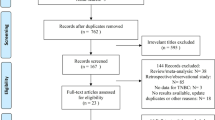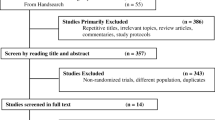Abstract
Background
Chemotherapy is the standard treatment for triple-negative breast cancer (TNBC). Whether the addition of PARP inhibitors improves treatment efficacy remains controversial clinically. Thus, we performed a meta-analysis to compare the efficacy and safety of combination treatment (PC) and chemotherapy alone (CA).
Methods
Relevant studies were identified through searches of 7 databases. The primary endpoints were progression-free survival (PFS) and overall survival (OS).
Results
We screened 317 studies and included seven RCTs involving 2091 patients in the final analysis. PC tended to have better efficacy than CA according to PFS (HR [hazard ratio]: 0.83 [0.75, 0.93], p = 0.001), OS (HR: 0.89 [0.76,1.03], p = 0.11) and overall response rate (ORR) (RR [risk ratio]: 1.19 [0.97,1.46], p = 0.10). However, grade 3–5 AEs (RR: 1.50 [0.87,2.61], p = 0.15) were observed in the PC group. In the PC arm, the 10 most-reported grade 3–5 AEs were neutropenia (62.8%), anemia (28.5%), thrombocytopenia (26.4%), lymphopenia (19.05%), leukopenia (16.9%), fatigue (5%), heart failure (4.76%), lung infection (4.76%), thromboembolic events (4.76%) and ventricular tachycardia (4.76%). Similar results for pathological complete response (pCR), total AEs, rate of complete response (CR), stable disease (SD) and progressive disease (PD), breast conservation rate (BCR), and drug discontinuation (DD) rate were found between the two groups.
Conclusions
For TNBC treatment, the combination of PARP inhibitors and chemotherapy appears to be superior to chemotherapy alone with better antitumor efficacy. However, its higher rate of AEs needs to be taken seriously. More high-quality RCTs are needed to confirm these results.




Similar content being viewed by others
Availability of data and materials
The data sets used and/or analyzed during the current study are available from the corresponding author on reasonable request.
Abbreviations
- AEs:
-
Adverse effects
- BCR:
-
Breast conservation rate
- BRCA:
-
Breast cancer susceptibility gene
- CA:
-
Chemotherapy alone
- CR:
-
Complete response
- CI:
-
Confidence interval
- DD:
-
Drug discontinuation
- DCR:
-
Disease control rate
- ER:
-
Estrogen receptor
- ECOG:
-
Eastern Cooperative Oncology Group
- GRADE:
-
Grades of Recommendations Assessment, Development and Evaluation
- HR:
-
Hazard ratio
- HER2:
-
Human epidermal growth factor receptor-2
- OS:
-
Overall survival
- ORR:
-
Overall response rate
- PARP:
-
Poly ADP-ribose polymerase
- PARPi:
-
Poly ADP-ribose polymerase inhibitor
- PC:
-
PARP inhibitor plus chemotherapy
- PFS:
-
Progression-free study
- pCR:
-
Pathological complete response
- PD:
-
Progressive disease
- PR:
-
Progesterone receptor
- PR:
-
Partial response
- PRISMA:
-
Preferred Reporting Items for Systematic Reviews and Meta-Analyses
- RCT:
-
Randomised controlled study
- RR:
-
Risk ratio
- SD:
-
Stable disease
- SSB:
-
Single-strand break
- TNBC:
-
Triple-negative breast cancer
- TNM:
-
Tumor node metastasis
References
Siegel RL, Miller KD, Fuchs HE, Jemal A (2022) Cancer statistics, 2022. CA Cancer J Clin 72(1):7–33
Fahad UM (2019) Breast cancer: current perspectives on the disease status. Adv Exp Med Biol 1152:51–64
Budh DP, Sapra A (2022) Breast cancer screening. 2022 17. In: StatPearls. Treasure Island (FL): StatPearls Publishing.
Ben Aziz M, Mukhdomi T (2022) Regional anesthesia for breast reconstruction. 2022 19. In: StatPearls. Treasure Island (FL): StatPearls Publishing.
Wolff AC, Hammond ME, Hicks DG, Dowsett M, McShane LM, Allison KH et al (2013) Recommendations for human epidermal growth factor receptor 2 testing in breast cancer: American Society of Clinical Oncology/College of American Pathologists clinical practice guideline update. J Clin Oncol 31(31):3997–4013
Yin L, Duan JJ, Bian XW, Yu SC (2020) Triple-negative breast cancer molecular subtyping and treatment progress. Breast Cancer Res 22(1):61
Morris GJ, Naidu S, Topham AK, Guiles F, Xu Y, McCue P et al (2007) Differences in breast carcinoma characteristics in newly diagnosed African-American and Caucasian patients: a single-institution compilation compared with the National Cancer Institute’s Surveillance, Epidemiology, and End Results database. Cancer 110(4):876–884
Dent R, Trudeau M, Pritchard KI, Hanna WM, Kahn HK, Sawka CA et al (2007) Triple-negative breast cancer: clinical features and patterns of recurrence. Clin Cancer Res 13(15 Pt 1):4429–4434
Bergin ART, Loi S (2019) Triple-negative breast cancer: recent treatment advances. F1000Res 8:F1000 Faculty Rev-1342.
Chen Z, Wang X, Li X, Zhou Y, Chen K (2021) Deep exploration of PARP inhibitors in breast cancer: monotherapy and combination therapy. J Int Med Res 49(2):300060521991019
Bjarnason NH, Hitz M, Jorgensen NR, Vestergaard P (2008) Adverse bone effects during pharmacological breast cancer therapy. Acta Oncol 47(4):747–754
Chaudhary LN, Wilkinson KH, Kong A (2018) Triple-negative breast cancer: who should receive neoadjuvant chemotherapy? Surg Oncol Clin N Am 27(1):141–153
JabbarzadehKaboli P, Salimian F, Aghapour S, Xiang S, Zhao Q, Li M et al (2020) Akt-targeted therapy as a promising strategy to overcome drug resistance in breast cancer—a comprehensive review from chemotherapy to immunotherapy. Pharmacol Res 156:104806
Lebert JM, Lester R, Powell E, Seal M, McCarthy J (2018) Advances in the systemic treatment of triple-negative breast cancer. Curr Oncol 25(Suppl 1):S142–S150
Keenan TE, Tolaney SM (2020) Role of immunotherapy in triple-negative breast cancer. J Natl Compr Canc Netw 18(4):479–489
Rizzo A, Ricci AD (2022) Biomarkers for breast cancer immunotherapy: PD-L1, TILs, and beyond. Expert Opin Investig Drugs 31(6):549–555
Rizzo A, Ricci AD, Lanotte L, Lombardi L, Di Federico A, Brandi G et al (2022) Immune-based combinations for metastatic triple negative breast cancer in clinical trials: current knowledge and therapeutic prospects. Expert Opin Investig Drugs 31(6):557–565
Massafra R, Bove S, La Forgia D, Comes MC, Didonna V, Gatta G et al (2022) An invasive disease event-free survival analysis to investigate Ki67 role with respect to breast cancer patients’ age: a retrospective cohort study. Cancers (Basel) 14(9):2215
Rizzo A, Cusmai A, Acquafredda S, Rinaldi L, Palmiotti G (2022) Ladiratuzumab vedotin for metastatic triple negative cancer: preliminary results, key challenges, and clinical potential. Expert Opin Investig Drugs 31(6):495–498
Pantelidou C, Sonzogni O, De Oliveria TM, Mehta AK, Kothari A, Wang D et al (2019) PARP inhibitor efficacy depends on CD8+ T-cell recruitment via intratumoral STING pathway activation in BRCA-deficient models of triple-negative breast cancer. Cancer Discov 9(6):722–737
Eikesdal HP, Yndestad S, Elzawahry A, Llop-Guevara A, Gilje B, Blix ES et al (2021) Olaparib monotherapy as primary treatment in unselected triple negative breast cancer. Ann Oncol 32(2):240–249
Topçul M, Çeti NİL, ÖzbaşTuran S, KolusayinOzar MÖ (2018) In vitro cytotoxic effect of PARP inhibitor alone and in combination with nab-paclitaxel on triple-negative and luminal A breast cancer cells. Oncol Rep 40(1):527–535
D’Andrea AD (2018) Mechanisms of PARP inhibitor sensitivity and resistance. DNA Repair (Amst) 71:172–176
Sonnenblick A, de Azambuja E, Azim HA Jr, Piccart M (2015) An update on PARP inhibitors–moving to the adjuvant setting. Nat Rev Clin Oncol 12(1):27–41
Diéras V, Han HS, Kaufman B, Wildiers H, Friedlander M, Ayoub JP et al (2020) Veliparib with carboplatin and paclitaxel in BRCA-mutated advanced breast cancer (BROCADE3): a randomised, double-blind, placebo-controlled, phase 3 trial. Lancet Oncol 21(10):1269–1282
Loibl S, O’Shaughnessy J, Untch M, Sikov WM, Rugo HS, McKee MD et al (2018) Addition of the PARP inhibitor veliparib plus carboplatin or carboplatin alone to standard neoadjuvant chemotherapy in triple-negative breast cancer (BrighTNess): a randomised, phase 3 trial. Lancet Oncol 19(4):497–509
Rugo HS, Olopade OI, DeMichele A, Yau C, Van’t Veer LJ, Buxton MB et al (2016) Adaptive randomization of veliparib-carboplatin treatment in breast cancer. N Engl J Med 375(1):23–34
Kummar S, Wade JL, Oza AM, Sullivan D, Chen AP, Gandara DR et al (2016) Randomized phase II trial of cyclophosphamide and the oral poly (ADP-ribose) polymerase inhibitor veliparib in patients with recurrent, advanced triple-negative breast cancer. Invest New Drugs 34(3):355–363
O’Shaughnessy J, Osborne C, Pippen JE, Yoffe M, Patt D, Rocha C et al (2011) Iniparib plus chemotherapy in metastatic triple-negative breast cancer. N Engl J Med 364(3):205–214
O’Shaughnessy J, Schwartzberg L, Danso MA, Miller KD, Rugo HS, Neubauer M et al (2014) Phase III study of iniparib plus gemcitabine and carboplatin versus gemcitabine and carboplatin in patients with metastatic triple-negative breast cancer. J Clin Oncol 32(34):3840–3847
Llombart-Cussac A, Bermejo B, Villanueva C, Delaloge S, Morales S, Balmaña J et al (2015) SOLTI NeoPARP: a phase II randomized study of two schedules of iniparib plus paclitaxel versus paclitaxel alone as neoadjuvant therapy in patients with triple-negative breast cancer. Breast Cancer Res Treat 154(2):351–357
Jadad AR, Moore RA, Carroll D, Jenkinson C, Reynolds DJ, Gavaghan DJ et al (1996) Assessing the quality of reports of randomized clinical trials: is blinding necessary? Control Clin Trials 17(1):1–12
Guyatt GH, Oxman AD, Schünemann HJ, Tugwell P, Knottnerus A (2011) GRADE guidelines: a new series of articles in the Journal of Clinical Epidemiology. J Clin Epidemiol 64(4):380–382
Litton JK, Rugo HS, Ettl J, Hurvitz SA, Gonçalves A, Lee KH et al (2018) Talazoparib in patients with advanced breast cancer and a germline BRCA mutation. N Engl J Med 379(8):753–763
Robson M, Im SA, Senkus E, Xu B, Domchek SM, Masuda N et al (2017) Olaparib for metastatic breast cancer in patients with a germline BRCA mutation. N Engl J Med 377(6):523–533
Tutt A, Tovey H, Cheang MCU, Kernaghan S, Kilburn L, Gazinska P et al (2018) Carboplatin in BRCA1/2-mutated and triple-negative breast cancer BRCAness subgroups: the TNT Trial. Nat Med 24(5):628–637
Hashimoto K, Tamura K (2010) Breakthrough breast cancer treatment-PARP inhibitor, BRCA, and triple negative breast cancer. Gan To Kagaku Ryoho 37(7):1187–1191
Sikov WM, Berry DA, Perou CM, Singh B, Cirrincione CT, Tolaney SM et al (2015) Impact of the addition of carboplatin and/or bevacizumab to neoadjuvant once-per-week paclitaxel followed by dose-dense doxorubicin and cyclophosphamide on pathologic complete response rates in stage II to III triple-negative breast cancer: CALGB 40603 (Alliance). J Clin Oncol 33(1):13–21
Funding
This study was supported by National Natural Science Foundation of China (NSFC, Grant number: 81560345) and Natural Science Foundation of Jiangxi Province (Grant number: 20212BAB206050, 20192ACBL21036). Role of the Funding: The funding had no role in the design and conduct of the study; collection, management, analysis, and interpretation of the data; preparation, review, or approval of the manuscript; and decision to submit the manuscript for publication.
Author information
Authors and Affiliations
Contributions
WZ had full access to all the data in the manuscript and takes responsibility for the integrity of the data and the accuracy of the data analysis. All authors read and approved the final manuscript. Concept and design: all authors. Acquisition, analysis, or interpretation of data: all authors. Drafting of the manuscript: CL and WZ. Critical revision of the manuscript for important intellectual content: CL, SD and FY. Statistical analysis: CL, MH, ZF and JD. Supervision: CL and WZ.
Corresponding author
Ethics declarations
Conflict of interest
The authors certify that there is no conflict of interest regarding this manuscript.
Ethical approval and consent
This article does not contain any studies with human participants or animals performed by any of the authors.
Informed consent
For this type of study formal consent is not required.
Additional information
Publisher's Note
Springer Nature remains neutral with regard to jurisdictional claims in published maps and institutional affiliations.
Supplementary Information
Below is the link to the electronic supplementary material.
280_2023_4506_MOESM3_ESM.tif
Figure S3 Forest plots of RR of all-grade AEs associated with PC vs CA (including subgroup analysis of 10 most-reported AEs according to the combination of both arms) (TIF 16933 KB)
280_2023_4506_MOESM4_ESM.tif
Figure S4 Forest plots of RR of grade 3-5 AEs associated with PC vs CA (including subgroup analysis of 10 most-reported grade 3-5 AEs according to the combination of both arms) (TIF 16825 KB)
Rights and permissions
Springer Nature or its licensor (e.g. a society or other partner) holds exclusive rights to this article under a publishing agreement with the author(s) or other rightsholder(s); author self-archiving of the accepted manuscript version of this article is solely governed by the terms of such publishing agreement and applicable law.
About this article
Cite this article
Li, C., Hao, M., Fang, Z. et al. PARP inhibitor plus chemotherapy versus chemotherapy alone in patients with triple-negative breast cancer: a systematic review and meta-analysis based on randomized controlled trials. Cancer Chemother Pharmacol 91, 203–217 (2023). https://doi.org/10.1007/s00280-023-04506-x
Received:
Accepted:
Published:
Issue Date:
DOI: https://doi.org/10.1007/s00280-023-04506-x




